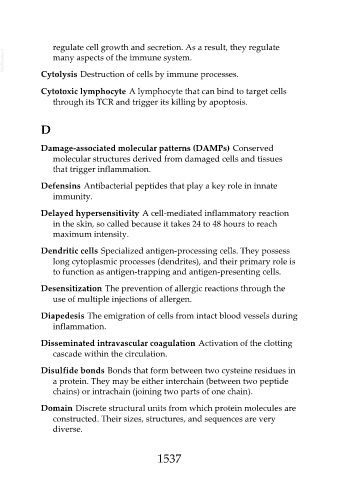Page 1537 - Veterinary Immunology, 10th Edition
P. 1537
regulate cell growth and secretion. As a result, they regulate
VetBooks.ir many aspects of the immune system.
Cytolysis Destruction of cells by immune processes.
Cytotoxic lymphocyte A lymphocyte that can bind to target cells
through its TCR and trigger its killing by apoptosis.
D
Damage-associated molecular patterns (DAMPs) Conserved
molecular structures derived from damaged cells and tissues
that trigger inflammation.
Defensins Antibacterial peptides that play a key role in innate
immunity.
Delayed hypersensitivity A cell-mediated inflammatory reaction
in the skin, so called because it takes 24 to 48 hours to reach
maximum intensity.
Dendritic cells Specialized antigen-processing cells. They possess
long cytoplasmic processes (dendrites), and their primary role is
to function as antigen-trapping and antigen-presenting cells.
Desensitization The prevention of allergic reactions through the
use of multiple injections of allergen.
Diapedesis The emigration of cells from intact blood vessels during
inflammation.
Disseminated intravascular coagulation Activation of the clotting
cascade within the circulation.
Disulfide bonds Bonds that form between two cysteine residues in
a protein. They may be either interchain (between two peptide
chains) or intrachain (joining two parts of one chain).
Domain Discrete structural units from which protein molecules are
constructed. Their sizes, structures, and sequences are very
diverse.
1537

